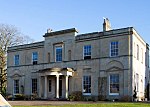Backwell
Civil parishes in SomersetOpenDomesdayUse British English from August 2012Villages in North Somerset

Backwell is a village and civil parish in the unitary authority of North Somerset and in 2011 had a population of 4,589. The village lies about 7 miles (11 km) southwest of Bristol, south of the A370 to Weston-super-Mare. The parish includes the hamlets of Backwell Common, Backwell Green, and Backwell Farleigh, and the districts of Backwell West Town and Downside.Nearby are Nailsea, Flax Bourton, Yatton, Brockley and Barrow Gurney.
Excerpt from the Wikipedia article Backwell (License: CC BY-SA 3.0, Authors, Images).Backwell
St Andrews Road,
Geographical coordinates (GPS) Address Nearby Places Show on map
Geographical coordinates (GPS)
| Latitude | Longitude |
|---|---|
| N 51.4131 ° | E -2.7398 ° |
Address
St Andrews Road 12
BS48 3NR
England, United Kingdom
Open on Google Maps









